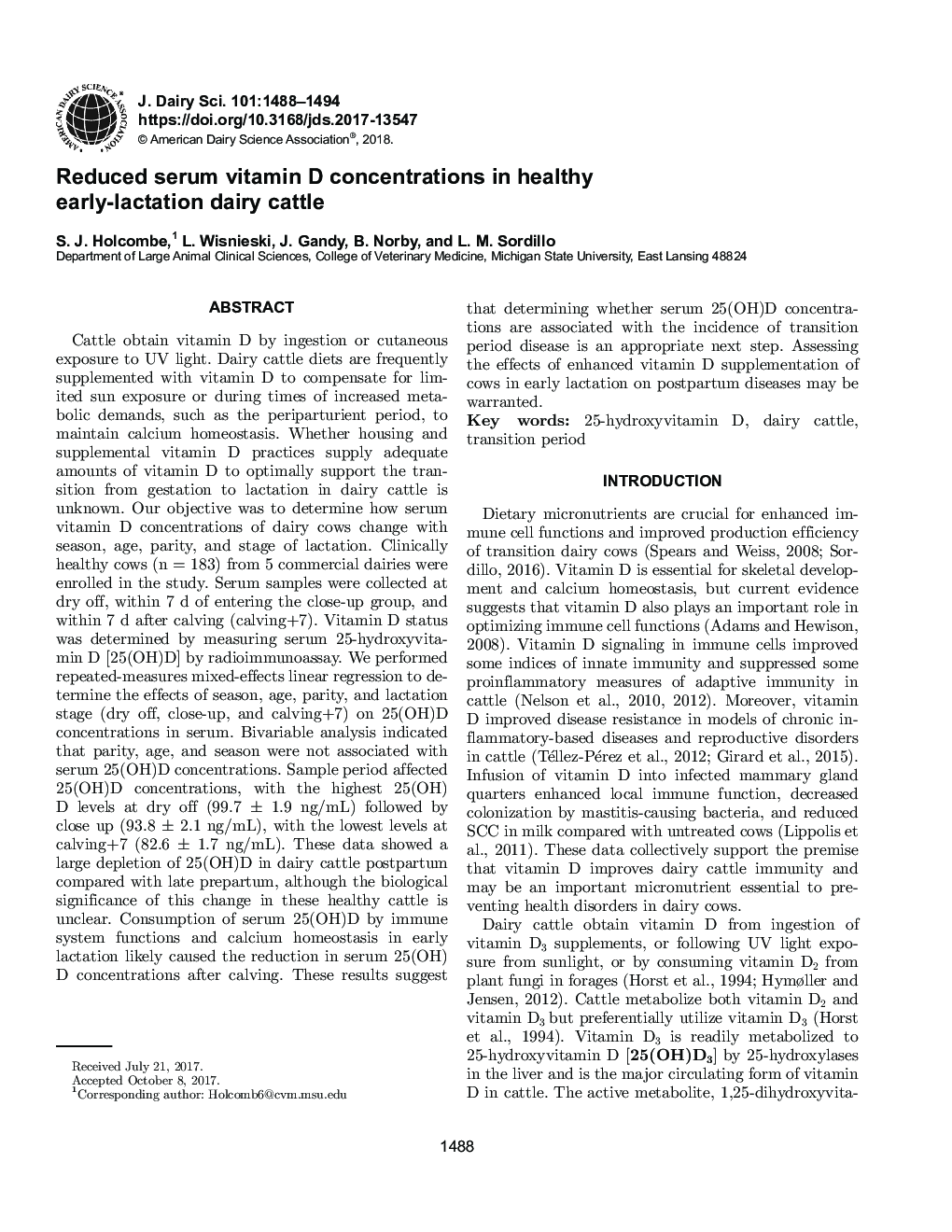| کد مقاله | کد نشریه | سال انتشار | مقاله انگلیسی | نسخه تمام متن |
|---|---|---|---|---|
| 8501675 | 1553843 | 2018 | 7 صفحه PDF | دانلود رایگان |
عنوان انگلیسی مقاله ISI
Reduced serum vitamin D concentrations in healthy early-lactation dairy cattle
دانلود مقاله + سفارش ترجمه
دانلود مقاله ISI انگلیسی
رایگان برای ایرانیان
کلمات کلیدی
موضوعات مرتبط
علوم زیستی و بیوفناوری
علوم کشاورزی و بیولوژیک
علوم دامی و جانورشناسی
پیش نمایش صفحه اول مقاله

چکیده انگلیسی
Cattle obtain vitamin D by ingestion or cutaneous exposure to UV light. Dairy cattle diets are frequently supplemented with vitamin D to compensate for limited sun exposure or during times of increased metabolic demands, such as the periparturient period, to maintain calcium homeostasis. Whether housing and supplemental vitamin D practices supply adequate amounts of vitamin D to optimally support the transition from gestation to lactation in dairy cattle is unknown. Our objective was to determine how serum vitamin D concentrations of dairy cows change with season, age, parity, and stage of lactation. Clinically healthy cows (n = 183) from 5 commercial dairies were enrolled in the study. Serum samples were collected at dry off, within 7 d of entering the close-up group, and within 7 d after calving (calving+7). Vitamin D status was determined by measuring serum 25-hydroxyvitamin D [25(OH)D] by radioimmunoassay. We performed repeated-measures mixed-effects linear regression to determine the effects of season, age, parity, and lactation stage (dry off, close-up, and calving+7) on 25(OH)D concentrations in serum. Bivariable analysis indicated that parity, age, and season were not associated with serum 25(OH)D concentrations. Sample period affected 25(OH)D concentrations, with the highest 25(OH)D levels at dry off (99.7 ± 1.9 ng/mL) followed by close up (93.8 ± 2.1 ng/mL), with the lowest levels at calving+7 (82.6 ± 1.7 ng/mL). These data showed a large depletion of 25(OH)D in dairy cattle postpartum compared with late prepartum, although the biological significance of this change in these healthy cattle is unclear. Consumption of serum 25(OH)D by immune system functions and calcium homeostasis in early lactation likely caused the reduction in serum 25(OH)D concentrations after calving. These results suggest that determining whether serum 25(OH)D concentrations are associated with the incidence of transition period disease is an appropriate next step. Assessing the effects of enhanced vitamin D supplementation of cows in early lactation on postpartum diseases may be warranted.
ناشر
Database: Elsevier - ScienceDirect (ساینس دایرکت)
Journal: Journal of Dairy Science - Volume 101, Issue 2, February 2018, Pages 1488-1494
Journal: Journal of Dairy Science - Volume 101, Issue 2, February 2018, Pages 1488-1494
نویسندگان
S.J. Holcombe, L. Wisnieski, J. Gandy, B. Norby, L.M. Sordillo,